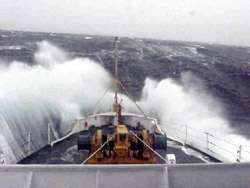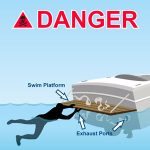If caught in heavy weather, make sure everyone on board is wearing a life jacket. If offshore, jot down your current location. Reduce speed, secure all loose objects and rigging on deck, close or cover all hatches and openings, and put on a PFD. Also, make sure distress signals and life rafts are readily accessible. Turn toward the wind and approach waves at about 45 degrees. Stay low in the boat.
If you’d like to know where the approximate center of a low pressure area is located (the source of most unstable weather), face the wind and extend your right arm out from your body about 100 degrees (a little further toward your back than sideways). You’ll be pointing at it. If most storms generally approach your local area from the south, west, or southwest, for example, and your arm is pointing in that direction, you can be pretty certain the low is moving in your general direction. On the other hand, if you’re pointing northwest, north, northeast, east, or southeast, the low is probably skirting you, or has already passed. You can then take appropriate action. This method of approximating the center of a low pressure area is called “Buys-Ballot’s Law”. (And, by the way, if you’re in the Southern hemisphere, use the other arm.)
There are rules to follow so that you don’t get struck by lightning on the water, but nobody knows what they are. As a matter of fact, lightning is so unpredictable, that there is no guaranteed, sure-fire protection against being struck. You can take some precautions, like having your boat’s bonding system grounded to the water, and constructing a “grounded” mast to a large underwater copper plate to provide a “cone of protection”. But the best way to be safe from a lightning strike is to avoid being out in a lightning storm. If you can’t, then have everybody put on a life jacket, have them put on rubber soled shoes if available, and have them sit down on the floor away from electrical panels and electronic gear. Never any guarantees with lightning, but you may decrease your chances of being struck. One nice thing to know, however, is that lightning strikes on land far outnumber strikes on the water. So that should give you SOME sense of well-being.
Always monitor the weather forecast before going out on the water, whether its just for a day of water-skiing, or the first leg of an around-the-world cruise. TV and radio forecasts are good sources for local weather information. Then after you’re on the water, watch for signs of changes in the weather. Rising or changing winds, darkening or thickening clouds, and sudden drops in temperature may all be signs of instability. When in doubt, get off the water.








